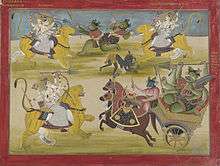Sumbha and Nisumbha

In the Hindu text the Devi Mahatmyam, Sumbha and Nisumbha, also spelled as Shumbha and Nishumbha, were two Asuras that confronted, and were ultimately slain by, Devi or Durga.
In the Devi Mahatmyam
The story of Sumbha and Nisumbha begins in the fifth chapter of the Devi Mahatmyam. The Devi relates how two brothers of Asura stock sought to conquer the Three Worlds by subjecting themselves to severe penance and purification rituals so that no man or demon could destroy them.[1] Sumbha and Nisumbha traveled to Pushkara, a sacred place, and remained there in prayer for ten thousand years. God Brahma saw the brothers' penitence, and was pleased, granting them the boon they requested.[2]
It was at this time that Chanda and Munda, two lesser Asuras in the service of Sumbha, encountered the Devi, and were overwhelmed by her beauty. They carried reports of this goddess to Sumbha, who sought to possess the Devi and her beauty. Sumbha sent the demon Sugriva to court the Devi, but she rejected his advances. It was then decided by the demonic brothers that if the Devi would not come willingly, they would have to abduct her. The demon Dhoomralocana and his retinue of sixty-thousand Asuras were sent to kidnap the Devi, but she and her lion-steed managed to slay the entire army. Next, Chanda and Munda were deployed, but the Devi destroyed them as well.[2]
Death
After these encounters, Sumbha and Nisumbha had no choice but to meet the Devi in direct combat. Although Brahma's boon had granted the brothers protection against men and demons, no such protection existed against goddesses. Nisumbha was the first to fall, after assaulting the Devi's lion.[3] After Nisumbha's death, a powerful demon emerged from his corpse, but Devi managed to dispatch this monster as well, by decapitating it. Upon seeing the death of his brother, Sumbha went after the Devi in a rage, but was ultimately cleaved in two by the Goddess' trident. With Sumbha and Nisumbha gone, the Three Worlds returned to their ordinary state of being, rid of a great evil.[4]
In popular culture
Some, such as John Stratton Hawley and Donna Marie Wulff, see Shumbha and Nishumbha as symbols of arrogance and pride which is ultimately overcome by the Devi's humility and wisdom.[5]In Shashi Tharoor's satirical novel The Great Indian Novel, the story of Sumbha and Nisumbha is used both as a warning against the dangers of seduction, and as a metaphor for the collapse of the relationship between the five Pandavas.[6]
See also
- Devi Mahatmya
- Aloadae
- Markandeya Purana
- Chandi di Var
- Raktavija
- Munda
- Chanda
- Sumbha and Nisumbha
References
- ↑ "The Devi Mahatmya Navrathri Katha - Chapter 1 to 13". S-a-i.info. Retrieved 2009-01-29.
- 1 2 "The Devi". Sdbbs.tripod.com. Retrieved 2009-01-29.
- ↑ "Sri Durga Saptasati or The Devi Mahatmya". Sivanandaonline.org. Retrieved 2009-01-29.
- ↑ "Sri Durga Saptasati or The Devi Mahatmya". Sivanandaonline.org. Retrieved 2009-01-29.
- ↑ Hawley, John Stratton; Wulff, Donna Marie; Devī: Goddesses of India. Published by University of California Press, 1996: p. 68 ISBN 0-520-20058-6, ISBN 978-0-520-20058-6
- ↑ Tharoor, Shashi. The Great Indian Novel. Viking Press: 1989. ISBN 0-670-82744-4
